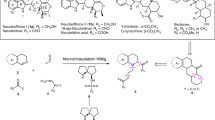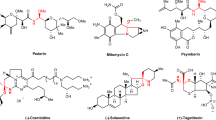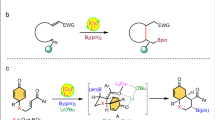Abstract
Enantioenriched α-aminoboronic acids play a unique role in medicinal chemistry and have emerged as privileged pharmacophores in proteasome inhibitors. Additionally, they represent synthetically useful chiral building blocks in organic synthesis. Recently, CuH-catalysed asymmetric alkene hydrofunctionalization has become a powerful tool to construct stereogenic carbon centres. By contrast, applying CuH cascade catalysis to achieve the reductive 1,1-difunctionalization of alkynes remains an important, but largely unaddressed, synthetic challenge. Herein, we report an efficient strategy to synthesize α-aminoboron compounds by a CuH-catalysed hydroboration/hydroamination cascade of readily available alkynes. Notably, this transformation selectively delivers the desired 1,1-heterodifunctionalized product rather than the alternative homodifunctionalized, 1,2-heterodifunctionalized or reductively monofunctionalized by-products, thereby offering rapid access to these privileged scaffolds with high chemo-, regio- and enantioselectivity.
This is a preview of subscription content, access via your institution
Access options
Access Nature and 54 other Nature Portfolio journals
Get Nature+, our best-value online-access subscription
$29.99 / 30 days
cancel any time
Subscribe to this journal
Receive 12 digital issues and online access to articles
$119.00 per year
only $9.92 per issue
Buy this article
- Purchase on Springer Link
- Instant access to full article PDF
Prices may be subject to local taxes which are calculated during checkout




Similar content being viewed by others
Data availability
Most of the data that support the findings of this study are available within the article and its Supplementary Information. Additional data are available from the corresponding author upon reasonable request.
References
Kolb, H. C., VanNieuwenhze, M. S. & Sharpless, K. B. Catalytic asymmetric dihydroxylation. Chem. Rev. 94, 2483–2547 (1994).
McDonald, R. I., Liu, G. & Stahl, S. S. Palladium(II)-catalyzed alkene functionalization via nucleopalladation: stereochemical pathways and enantioselective catalytic applications. Chem. Rev. 111, 2981–3019 (2011).
Derosa, J., Tran, V. T., van der Puyl, V. A. & Engle, K. M. Carbon–carbon π-bonds as conjunctive reagents in cross-coupling. Aldrichimica Acta 51, 21–32 (2018).
Sauer, G. S. & Lin, S. An electrocatalytic approach to the radical difunctionalization of alkenes. ACS Catal. 8, 5175–5187 (2018).
Nelson, H. M., Williams, B. D., Miró, J. & Toste, F. D. Enantioselective 1,1-arylborylation of alkenes: merging chiral anion phase transfer with Pd catalysis. J. Am. Chem. Soc. 137, 3213–3216 (2015).
Bergmann, A. M., Dorn, S. K., Smith, K. B., Logan, K. M. & Brown, M. K. Catalyst-controlled 1,2- and 1,1-arylboration of α-alkyl alkenyl arenes. Angew. Chem. Int. Ed. 58, 1719–1723 (2019).
Pirnot, M. T., Wang, Y.-M. & Buchwald, S. L. Copper hydride catalyzed hydroamination of alkenes and alkynes. Angew. Chem. Int. Ed. 55, 48–57 (2016).
Jordan, A. J., Lalic, G. & Sadighi, J. P. Coinage metal hydrides: synthesis, characterization, and reactivity. Chem. Rev. 116, 8318–8372 (2016).
Lin, S. et al. A modular and concise approach to MIDA acylboronates via chemoselective oxidation of unsymmetrical geminal diborylalkanes: unlocking access to a novel class of acylborons. Chem. Sci. 10, 4684–4691 (2019).
Shi, S.-L. & Buchwald, S. L. Copper-catalysed selective hydroamination reactions of alkynes. Nat. Chem. 7, 38–44 (2015).
Cheng, L.-J. & Mankad, N. P. Cu-catalyzed hydrocarbonylative C–C coupling of terminal alkynes with alkyl iodides. J. Am. Chem. Soc. 139, 10200–10203 (2017).
Yang, Y., Shi, S.-L., Niu, D., Liu, P. & Buchwald, S. L. Catalytic asymmetric hydroamination of unactivated internal olefins to aliphatic amines. Science 349, 62–66 (2015).
Armstrong, M. K. & Lalic, G. Differential dihydrofunctionalization of terminal alkynes: synthesis of benzylic alkyl boronates through reductive three-component coupling. J. Am. Chem. Soc. 141, 6173–6179 (2019).
Lee, J. C. H., McDonald, R. & Hall, D. G. Enantioselective preparation and chemoselective cross-coupling of 1,1-diboron compounds. Nat. Chem. 3, 894–899 (2011).
Feng, X., Jeon, H. & Yun, J. Regio- and enantioselective copper(I)-catalyzed hydroboration of borylalkenes: asymmetric synthesis of 1,1-diborylalkanes. Angew. Chem. Int. Ed. 52, 3989–3992 (2013).
Niljianskul, N., Zhu, S. & Buchwald, S. L. Enantioselective synthesis of α-aminosilanes by copper-catalyzed hydroamination of vinylsilanes. Angew. Chem. Int. Ed. 54, 1638–1641 (2015).
Nishikawa, D., Hirano, K. & Miura, M. Asymmetric synthesis of α-aminoboronic acid derivatives by copper-catalyzed enantioselective hydroamination. J. Am. Chem. Soc. 137, 15620–15623 (2015).
Kato, K., Hirano, K. & Miura, M. Synthesis of β-boryl-α-aminosilanes by copper-catalyzed aminoboration of vinylsilanes. Angew. Chem. Int. Ed. 55, 14400–14404 (2016).
Han, J. T., Jang, W. J., Kim, N. & Yun, J. Asymmetric synthesis of borylalkanes via copper-catalyzed enantioselective hydroallylation. J. Am. Chem. Soc. 138, 15146–15149 (2016).
Lee, J., Torker, S. & Hoveyda, A. H. Versatile homoallylic boronates by chemo-, SN2′-, diastereo- and enantioselective catalytic sequence of Cu−H addition to vinyl-B(pin)/allylic substitution. Angew. Chem. Int. Ed. 56, 821–826 (2017).
Bross, P. F. et al. Approval summary for bortezomib for injection in the treatment of multiple myeloma. Clin. Cancer Res. 10, 3954–3964 (2004).
Matteson, D. S. α-Amido boronic acids: a synthetic challenge and their properties as serine protease inhibitors. Med. Res. Rev. 28, 233–246 (2008).
Touchet, S., Carreaux, F., Carboni, B., Bouillon, A. & Boucher, J.-L. Aminoboronic acids and esters: from synthetic challenges to the discovery of unique classes of enzyme inhibitors. Chem. Soc. Rev. 40, 3895–3914 (2011).
Rentsch, A. et al. Synthesis and pharmacology of proteasome inhibitors. Angew. Chem. Int. Ed. 52, 5450–5488 (2013).
Ohmura, T., Awano, T. & Suginome, M. Stereospecific Suzuki–Miyaura coupling of chiral α-(acylamino)benzylboronic esters with inversion of configuration. J. Am. Chem. Soc. 132, 13191–13193 (2010).
Shiro, T., Schuhmacher, A., Jackl, M. K. & Bode, J. W. Facile synthesis of α-aminoboronic acids from amines and potassium acyltrifluoroborates (KATs) via trifluoroborate-iminiums (TIMs). Chem. Sci. 9, 5191–5196 (2018).
Matteson, D. S., Sadhu, K. M. & Lienhard, G. E. R-l-Acetamido-2-phenylethaneboronic acid. A specific transition-state analog for chymotrypsin. J. Am. Chem. Soc. 103, 5241–5242 (1981).
He, Z., Zajdlik, A., St. Denis, J. D., Assem, N. & Yudin, A. K. Boroalkyl group migration provides a versatile entry into α-aminoboronic acid derivatives. J. Am. Chem. Soc. 134, 9926–9929 (2012).
Zajdlik, A. et al. α-Boryl isocyanides enable facile preparation of bioactive boropeptides. Angew. Chem. Int. Ed. 52, 8411–8415 (2013).
Beenen, M. A., An, C. & Ellman, J. A. Asymmetric copper-catalyzed synthesis of α-amino boronate esters from N-tert-butanesulfinyl aldimines. J. Am. Chem. Soc. 130, 6910–6911 (2008).
Li, C. et al. Decarboxylative borylation. Science 356, eaam7355 (2017).
Hong, K. & Morken, J. P. Catalytic enantioselective one-pot aminoborylation of aldehydes: a strategy for construction of nonracemic α-amino boronates. J. Am. Chem. Soc. 135, 9252–9254 (2013).
Wang, D. et al. Copper(I)-catalyzed asymmetric pinacolboryl addition of N-Boc-imines using a chiral sulfoxide–phosphine ligand. Org. Lett. 17, 2420–2423 (2015).
Schwamb, C. B. et al. Enantioselective synthesis of α-amidoboronates catalyzed by planar-chiral NHC-Cu(I) complexes. J. Am. Chem. Soc. 140, 10644–10648 (2018).
Jang, H., Zhugralin, A. R., Lee, Y. & Hoveyda, A. H. Highly selective methods for synthesis of internal (α-) vinylboronates through efficient NHC−Cu-catalyzed hydroboration of terminal alkynes. Utility in chemical synthesis and mechanistic basis for selectivity. J. Am. Chem. Soc. 133, 7859–7871 (2011).
Jang, W. J., Lee, W. L., Moon, J. H., Lee, J. Y. & Yun, J. Copper-catalyzed trans-hydroboration of terminal aryl alkynes: stereodivergent synthesis of alkenylboron compounds. Org. Lett. 18, 1390–1393 (2016).
Bai, T., Yang, Y. & Han, C. Isolation and characterization of hydrocarbon soluble NHC copper(I) phosphoranimide complex and catalytic application for alkyne hydroboration reaction. Tetrahedron Lett. 58, 1523–1527 (2017).
Wang, H., Yang, J. C. & Buchwald, S. L. CuH-catalyzed regioselective intramolecular hydroamination for the synthesis of alkyl-substituted chiral aziridines. J. Am. Chem. Soc. 139, 8428–8431 (2017).
Bandar, J. S., Pirnot, M. T. & Buchwald, S. L. Mechanistic studies lead to dramatically improved reaction conditions for the Cu-catalyzed asymmetric hydroamination of olefins. J. Am. Chem. Soc. 137, 14812–14818 (2015).
Xia, Y. & Hartwig, J. F. Mechanistic studies of copper-catalyzed asymmetric hydroboration of alkenes. J. Am. Chem. Soc. 139, 12758–12772 (2017).
Lee, J., Radomkit, S., Torker, S., del Pozo, J. & Hoveyda, A. H. Mechanism-based enhancement of scope and enantioselectivity for reactions involving a copper-substituted stereogenic carbon centre. Nat. Chem. 10, 99–108 (2018).
Revunova, K. & Nikonov, G. I. Base-catalyzed hydrosilylation of ketones and esters and insight into the mechanism. Chem. Eur. J. 20, 839–845 (2014).
Laitar, D. S., Tsui, E. Y. & Sadighi, J. P. Copper(I) β-boroalkyls from alkene insertion: isolation and rearrangement. Organometallics 25, 2405–2408 (2006).
Jang, W. J., Han, J. T. & Yun, J. NHC-copper-catalyzed tandem hydrocupration and allylation of alkenyl boronates. Synthesis 49, 4753–4758 (2017).
Acknowledgements
D. G. Blackmond, D. E. Hill and J. S. Bandar are acknowledged for helpful discussions regarding the reaction mechanism. This work was financially supported by The Scripps Research Institute, Pfizer, Bristol-Myers Squibb (unrestricted grant) and the National Institutes of Health (5R35GM125052-02, R35GM128779). We gratefully acknowledge the Nankai University College of Chemistry for a Summer Project Scholarship (T.-Z.Q.) and the China Scholarship Council for supporting a visiting studentship (X.W.). Calculations were performed at the Center for Research Computing at the University of Pittsburgh and the Extreme Science and Engineering Discovery Environment (XSEDE) supported by the NSF.
Author information
Authors and Affiliations
Contributions
D.-W.G. and K.M.E. conceived the project. D.-W.G. optimized the reaction conditions. D.-W.G., Y.G., T.-Z.Q. and X.W. prepared substrates and examined the substrate scope. D.-W.G. and Y.G. studied the mechanism and explored the synthetic applications. H.S. and P.L. carried out DFT studies. B.B.S. and J.S.C. assisted with analytical aspects of the project. P.L. and K.M.E. directed the project. D.-W.G., Y.G., H.S., P.L. and K.M.E. wrote the manuscript with input from all authors.
Corresponding authors
Ethics declarations
Competing interests
The authors declare no competing interests.
Additional information
Publisher’s note Springer Nature remains neutral with regard to jurisdictional claims in published maps and institutional affiliations.
Supplementary information
Supplementary Information
Supplementary Methods, Figures 1–13 and references.
Supplementary Data 1
Coordinates of optimized structures.
NMR data
NMR data.
Rights and permissions
About this article
Cite this article
Gao, DW., Gao, Y., Shao, H. et al. Cascade CuH-catalysed conversion of alkynes into enantioenriched 1,1-disubstituted products. Nat Catal 3, 23–29 (2020). https://doi.org/10.1038/s41929-019-0384-6
Received:
Accepted:
Published:
Issue Date:
DOI: https://doi.org/10.1038/s41929-019-0384-6
This article is cited by
-
Copper-catalysed asymmetric hydroboration of alkenes with 1,2-benzazaborines to access chiral naphthalene isosteres
Nature Chemistry (2024)
-
Intramolecular hydroamidation of alkenes enabling asymmetric synthesis of β-lactams via transposed NiH catalysis
Nature Catalysis (2023)
-
Chemoselective chromium-catalysed cross-coupling enables three-component tertiary alkane synthesis
Nature Synthesis (2023)
-
O-Benzoylhydroxylamines: A Versatile Electrophilic Aminating Reagent for Transition Metal-Catalyzed C–N Bond-Forming Reactions
Topics in Current Chemistry (2023)
-
Ligand relay catalysis for cobalt-catalyzed sequential hydrosilylation and hydrohydrazidation of terminal alkynes
Nature Communications (2022)



